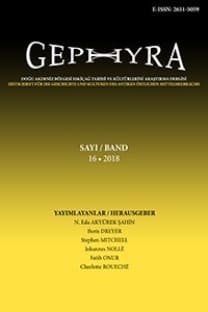Δημήτριος…ἀργυροκόπος ποιῶν ναοὺς ἀργυροῦς Ἀρτέμιδος: Demetrios’un Gümüş Tapınakları ve I. Claudius’un “Kistophor”ları (Bir Öneri)
Luka’nın Elçilerin İşleri’nde yer alan bir ‘gümüşçü’ olan Demetrios’un tiyatroda Artemis’i ve tapınağını rencide ettiği için Paulos’a karşı insanları tahrik ettiği meşhur sahne, bilhassa nümizmatik kanıt kullanılmadığı için henüz yeterince ele alınmamıştır. Ama asıl bu alan o skandalın iç yüzünü aydınlatmak için başka bir analitik fırsat vermektedir. Onlarda sadece Artemis’in gümüş tapınaklarının satışı iddialara göre Paulos tarafından tehlikeye atıldığına değinilmiş olduğu için, aynı zamana ait İmparator I. Claudius’a ait gümüş ‘kistophorlara’ yakından bakmaya değmektedir çünkü bunlar Artemision’un ve Artemis Ephesia’nın kült heykelinin resimlerini taşımaktadır. Üçüncü bir seride Augustus ve Dea Roma resmedilmektedir. Bu durum bu sikkelerin gayet resmi bir Roma işi olduğunu göstermektedir. Sikke damgalarının sadece en yüksek kalitede değil aynı zamanda Efes’e ait olmayan imparatorluk sikke basımının tarzında olmaları gerçeği bunu desteklemektedir. Bundan dolayı Efes’in kendi bronz sikkelerinde oldukça eyalet usulünce Claudius ve II. Agrippina’nın düğünlerini ‘tanrıların düğünü’ olarak kutlaması önem kazanmaktadır. Bu yüzden Demetrios’un gümüş tapınaklarının model olmaması ve ‘kistophorları’ simgelemesi olasılık dışı değildir. Böyle olunca da onlar anlaşıldığı gibi sadece para birimi değil tanrılara hediye anlamına gelmektedir. Tanrı ve imparatorun bağlantısında tabi ki Ephesia ve imparatorun birbirini karşılıklı olarak yükselttiği çerçevede ‘uluslararası’ bir siyaset görünmektedir. Arada, ürünleri için açıkçası iyi para kazanan ‘sikke ustası’ Demetrios vardı. Diğer yandan, Paulos, muhtemelen Yahudi düşmanları tarafından ilerletilen bir çeşit araç olarak görünmektedir.
Anahtar Kelimeler:
Kistophorlar, Ephesos, Artemis, Paulos
Δημήτριος…ἀργυροκόπος ποιῶν ναοὺς ἀργυροῦς Ἀρτέμιδος: The Silver Temples of Demetrios and the “Cistophori” of Claudius I (A Suggestion)
The well-known scene in Luke’s Acts of the Apostels according to which a certain “silversmith” Demetrios agitated at the theatre against Paul because he had offended Artemis and her temple has not yet been sufficiently dealt with as particularly the numismatic evidence was not exploited. But it is this field which offers another analytical chance to illuminate the background of the scandal. As there are mentioned only silver temples of Artemis the sale of which was allegedly endangered by Paul a closer look into those silver “cistophors” of contemporary emperor Claudius I is worthwhile for these bear the pictures of Artemisium and cult image of Artemis-Ephesia. On a third series there are represented Augustus and Dea Roma which shows that these coins were a highly official Roman affair. This is being underlined by the fact that the coin stamps are not only of the highest quality but are also of a non-Ephesian fashion close to the imperial coinage. Therefore, it is significant that Ephesos celebrated on its bronze coins the marriage of Claudius and Agrippina II as “marriage of Gods” in a rather provincial mode.So, it is not improbable that the silver temples of Demetrios were not models but stood for the “cistophors”. As such they were apparently ment as dona to the goddess and not only as currency. In the connexion of goddess and emperor, there is of course “international” policy evident in the frame of which the Ephesia enhanced the emperor and vice versa. In between there was the “mint master” Demetrios who as such gained evidently good money for his products. On the other hand, Paul seems to have been sort of a vehicle which was probably pushed forward by his Jewish enemies.
Keywords:
Cistophors, Ephesos, Artemis, Paul,
___
- R. Bohlen, in LThK 13, 2006.
- G. Elmer, Verzeichnis der römischen Reichsprägungen, Wien 1956.
- R. Fleischer, Artemis von Ephesos (EPRO 35), Leiden 1973.
- D. French, C. Atinius C. f. on a Coin of Ephesus, in: Recent Turkish Coin Hoards Oxbow Mon. 7, Oxford 1991.
- H. Herzfelder, The Cistophori of Hadrian, in: NC 5.16, London 1936
- G. K. Jenkins, Hellenistic Gold Coins of Ephesus, in: FS Akurgal, Anadolu/Anatolia 21, [1978-1980], Ankara 1987, 183-188.
- S. Karwiese, in: Anzeiger ÖAW, Wien 1976.
- S. Karwiese, Die Münzprägung von Ephesos (MvE) 1, Wien 1995.
- S. Karwiese, Groß ist die Artemis von Ephesos, Wien 1995.
- S. Karwiese, in: ÖJh 67, Beiblatt, Wien 1998.
- S. Karwiese, Die Münzprägung von Ephesos (MvE) 5, Wien 2012.
- S. Karwiese, Die Münzprägung von Ephesos (MvE) 5.2, Wien 2016.
- J. P. C. Kent et al., Die Römische Münze, München 1973.
- B. Laum, Heiliges Geld, Tübingen 1924.
- G. M. Rogers, The Sacred Identity of Ephesus, London 1991.
- R. Strelan, Paul, Artemis, and the Jews in Ephesus, Berlin 1996.
- A. Weiser, Die Apostelgeschichte (Ökumen. Taschenbuchkommentar zum NT 5/2), Gütersloh 1985.
- ISSN: 1309-3924
- Yayın Aralığı: Yılda 2 Sayı
- Başlangıç: 2004
- Yayıncı: Nalan Eda AKYÜREK ŞAHİN
Sayıdaki Diğer Makaleler
Erken Bizans Yazıtlarında Germen Şahıs Adları. Özel İsimler ve Kollektif Kimlik
Karyalıların İsimlerine Dair Notlar
Terrance Michael Patrick Duggan
Hitit Kralı I. Hattusili’nin Yıllıkları ve Kayıp Altın Heykeli
Küçük Asya’nın Geç Dönem Miltaşları
